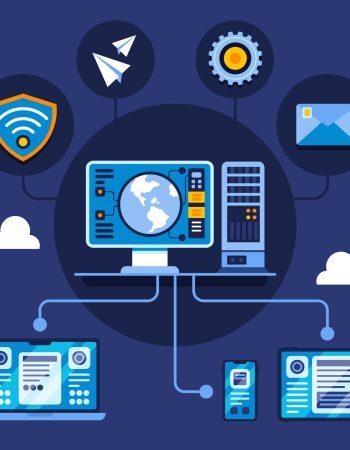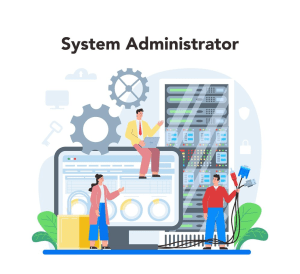A collection of two or more computers connected via wired or wireless networks is referred to as a computer network. A computer network system consists of various hardware components, such as hubs, switches, routers, and so forth.
One can also define computer networks based on their geographic location that connects computers in a definite physical dimension. Computer network systems are used all around the world by businesses, the entertainment industry, and education in the research field for communication and transforming their data from the source.
In the heart of our interconnected universe lies the world of computer network systems. Settle in dear readers and get ready, we are going on a journey to uncover the mysteries as well as wonders of connectivity. In this blog, we’ll also explore the fundamentals of computer network systems which will loaded with joy, wonder, and a touch of the magic of computer network systems.
Chapter 1: The Web of Connection
A vibrant community of computers, servers, routers, and switches are all connected by an invisible thread of data that my readers make the heart of a computer network system. Computer network services like network cabling and audio-visual enable communication for every business, entertainment, and research purpose. The internet, online search, email, audio and video sharing, online commerce, live streaming, and social networks all exist because of computer networks.
Here are some important terms and concepts of these web connections,
IP address: An IP address is a unique digit that is given to every device that is connected to a network of any type and uses the internet protocol communication. Each IP address identifies the host of the device’s network and the location of the device on the host network.
Nodes: A node connection indicates a network system that sends, receives, and creates as well as stores data. Here’s more, Each node wants to offer some form of identification to receive access like an IP address.
Routers: A router in a computer network system can be known as a physical or virtual device that shares information in the form of data packages within the networks. Additionally, they are capable of analyzing data within packets to identify the best way for information to go with.
Switches: A device that connects other devices as well as manages communication between nodes within a network is known as a switch. However, it makes sure that data packets will reach their desired destination. In computer networks, it also refers to how data is transferred between devices in a network.
Chapter 2: Building Bridges and Breaking Barriers
Computer networks connect elements like computers, routers, and switches by using cables, fiber optics, or wireless signals. Behold the mighty bridges known as routers and switches. These connections allow devices in a network to communicate and share information and resources. Additionally, networks follow standards that define communications as being sent and received as these standards allow devices to communicate. A string of numbers that uniquely recognize a device and allows other devices to identify it.
Routers are virtual and physical devices that encourage communication between different networks. Switches connect devices and build a bridge between node communication inside a network that ensures the collection of information that travels across the network reaches its ultimate destination. And fear not the barriers, with the magic of protocols like TCP/ IP and structured cabling, we can overcome any challenges that come in our path.
Chapter 3: From LAN to WAN
A local area network (LAN) concept computers over a relatively short distance, that allow them to share data, files, and resources. A LAN network has the capability to connect all the computers in an office building, or school and can owned and managed privately.
A personal area network (PAN) offers one person in a specific area. If you have one or two devices you have to set up a PAN to share and sync content.
A metropolitan area network (MAN) is typically larger than LAN but smaller than WAN. Cities and government entities typically own and manage MAN
A wide area network (WAN) allows one to connect with a wide area as its name implies from region to region or even continent. You will typically see collective or distributed ownership models for WAN management.
We do not have to worry about the limits of specific time and area; because of innovation in virtual private networks and wireless networks. However, every network has a unique personality and capabilities, whether it is located in the compact area of a LAN or the vast expanse of WAN, we can easily overcome limitations and consequences accordingly.
Chapter 4: The Languages
As a human being, we have to learn different languages to communicate with different individuals in different locations and be familiar with the local language. Exactly, in the digital world of computer networks, TCP, and HTTP are some languages that unlock the secrets of computer networks to use them effectively and the best. Individuals can learn and practice this language to be capable of conversing with devices near and far.
This language also allows you to set up a strong computer network according to your needs and requirements. Every small piece of information that is sent over the internet does not go to every device connected to the internet. The combination of protocols and infrastructure represents information exactly where they go.
Final Chapter: Power of Possibility
As we close the curtain of this computer network show, it’s time to reflect on the final chapter of possibilities. Interconnected and digital communication provides endless opportunities to widen our imagination and be with us at every operation. Change is constant and the only limit is our want to explore more in the world of computer networks.
Dear readers, these four chapters provide a detailed idea of the fundamentals of computer network systems and give a hint of the power of possibility that lies within each of us. Always remember, to dream big and dare to explore opportunities as this system is a boon for us to get success. In the world of computer network systems, the journey never ends, it only begins anew.



